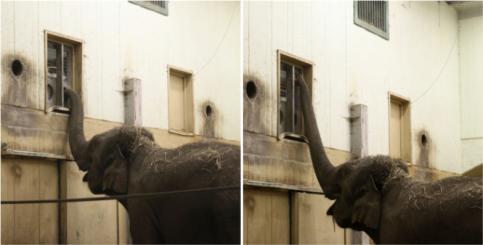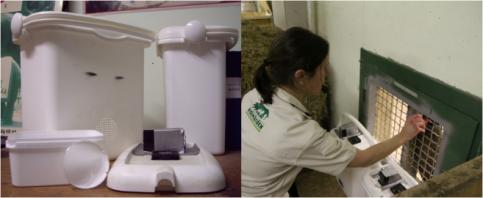Methods
The behavioral test and the experimental set-up
The study was conducted using three adult female Asian elephants housed at Kolmården Wildlife Park. The individuals were Saba (born 1968), Saonoi and Bua (born 1996 and 1997, respectively). The behavioral test was based on a food-rewarded two-alternative instrumental conditioning paradigm. The animals were taught to sample two odor ports and were food-rewarded when they performed an operant response (putting the trunk at a certain position of the experimental set-up) upon correctly identifying the rewarded odor. The training was carried out step-wise, where every new stage required a little bit more from the animals in order the gain access to the food-reward. The method was based on a voluntary participation of the animals and only positive reinforcement was used as a tool to shape the desired behavior.

In the method applied here, the animal had two options: (1) to correctly respond to the correct odor (correct decision), and (2) to falsely respond to the incorrect odor (incorrect decision). To measure performance the percentage of correct decisions per session was calculated for each individual and each session. In the initial learning tasks the criterion was set at 70 % hits, which corresponds to 21 correct out of 30 decisions in two consecutive sessions (corresponding to p < 0.01 two-tailed binomial test). In the discrimination tasks with structurally related odorants the criterion was set to 66.7 % correct in two consecutive sessions of 30 decisions each (corresponding to p < 0.05 two-tailed binomial test).

The odorants were presented to the animals in ventilated odor boxes and in pairs according to a previously determined order. A total of 10 experiments were conducted:
For the initial acquisition of the olfactory discrimination paradigm a set of eight odorants was used (amyl acetate, anethole, carvone, cineol, ethyl butyrate, limonene, pinene and 2-phenylethanol). For the assessment of odor discrimination capability with structurally related odorants, a set of four acetic esters was used (amyl acetate, butyl acetate, propyl acetate and ethyl acetate). The odorants were diluted at approximately equal subjective intensities, before presented to the animals.
Responsible for this page:
Director of undergraduate studies Biology
Last updated:
05/20/11
